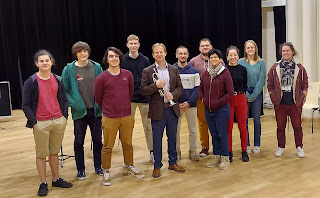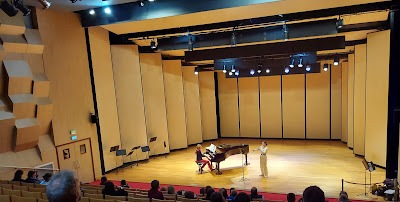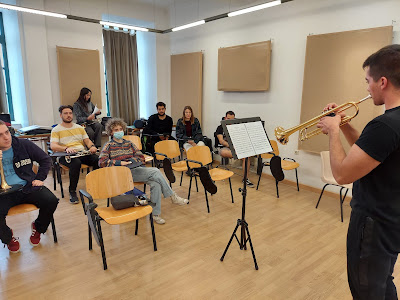All
brass musicians seem to invoke temperature in their playing and teaching in
some way or another. Whether it is a performer wanting to “warm-up,” or a
teacher telling their student to blow “hot” air into their instrument for some
pedagogical purpose, or a conductor confronting their ensemble’s intonation
issues due to temperature of the rehearsal room, temperature is an important
element of instrumental music. In spite of the ubiquitous usage of temperature
terminology among musicians, there seems to be little actual research on
temperature as it pertains to brass performance and pedagogy.
I recently searched the International Trumpet Guild (ITG) index of ITG Journal and ITG Newsletter articles, and found that in the nearly 50-year history of ITG, there have only been two articles ever published on the topic of air temperature. In both cases, the article was narrowly focused on the effect of air temperature on intonation. I have found zero articles discussing the pedagogy of air temperature. This article will attempt to explain and demystify temperature as it relates to playing brass instruments.
What is Temperature?
Temperature is important to brass players because, ultimately, temperature is a measurement of speed. Temperature measures the speed, or kinetic energy, of molecules within the air.
According to the authors of The Science of Brass Instruments, “The speed of sound in air is proportional to the square root of the absolute temperature.” (p. 277, cited below)
There are two basic temperatures that every reader should already know: body temperature and room temperature. Human body temperature is usually 98.6°F (or 37°C) and “normal” room temperature is usually somewhere around 70°F (around 21°C). Note that there is a difference of 28.6 degrees Fahrenheit of these two temperatures. We will soon see why this disparity is important to brass players.
Temperature and Range
Many brass players use air temperature as a pedagogical tool. For example, some teachers want students to make the air hotter in the belief that changing the air temperature to “hot” will result in a better tone quality. Some teachers are more specific than that, and instruct students to blow “warmer” air for lower notes, and “colder” air for higher notes. Some teachers use illustrations to achieve what they perceive as the optimal air temperature, such as “fog up a mirror” for low notes or “blow out a candle” for higher notes.
On the surface, these instructions seem to make a lot of sense. Certainly, if we open our oral cavity as if playing a low note, and blow on our hand through a wide mouth opening, the air probably seems warm. And, if blow through a smaller opening and/or arch our tongue, we seem to feel colder air. However, there are at least two problems with this way of thinking. First, one law of science is that compressed air gets hotter. Remember, temperature is a measure of speed-- Compressing air molecules makes them move faster, raising the temperature.
In other words, it sounds like we are exactly backwards in our reasoning about air temperature and range—but there’s actually more to the story.
In truth, the temperature of the exhaled breath changes very little—exhaled air is generally very close to human body temperature; what changes is actually just our perception of the exhaled air temperature.
When we exhale in a manner that feels “cold’ on our hand, it’s because the faster moving air mixes more quickly with the room air, and so what we feel on our hand feels colder since the room temperature is (usually) colder than our body temperature. In other words, we are feeling a temperature on our hand closer to room temperature. As mentioned above, normal human body temperature is around 98.6°F, whereas room temperature is usually much cooler, more like 70°F.
The Bernoulli Effect is a more scientifically specific explanation for why air blown on the hand can feel cold. Brass players who have studied the embouchure may be familiar with Daniel Bernoulli principle; said succinctly, Bernoulli proved that an increase in the speed of a fluid occurs simultaneously with a decrease in pressure. The decrease in pressure caused by the increase in speed causes the blown air to mix more quickly with the room air.
Another explanation is that fast moving air enhances the rate of convective heat transfer, which means we feel cooler. Just like a fan is blowing on you during a hot summer day… the moving air feels cooler than it actually is.
If you are not yet convinced, here is a simple experiment to confirm this phenomenon:
Fold a sheet of paper into a cylinder. Blow in one end, and feel the air coming out the other end with your hand. (Make sure hand is positioned close to the end of the cylinder so you can feel the air directly as it exits, before it mixes with the room air.) What you will feel coming out the end of the paper is hot air. This is because the paper prevents the hot air from mixing with the cold air in the room, even though it travels many inches away from your body.
You will discover that no matter how much you try to manipulate the air temperature, if you feel the air before it mixes with the room air, it will always feel hot to the touch of the hand.
The temperature of the exhaled breath is right around body temperature—although the beginning of the exhale tends to be a bit colder (because it hasn’t been warmed up by the body as much yet) and the end of the exhale tends to be a little bit warmer.
You will probably remember from your elementary school science courses that we inhale oxygen and exhale carbon dioxide. Plants make oxygen for us and we make carbon dioxide for the plants. As a side note (and to be as precise as possible for readers who want to dive deeper) while it’s true that air that we inhale will take on the temperature of our body, it’s possible that it does not heat quite all the way up to 98.6°F (or 37°C). It’s also true that not 100% of our expired air is carbon dioxide. The authors of The Science of Brass Instruments write, “The breath from the mouth of the player enters the instrument at a temperature of around 35°C (95°F) and includes significant proportions of water vapour and carbon dioxide as well as oxygen and nitrogen” (Science of Brass Instruments, p 312, reference found below)
As a whimsical side note, when I was researching this topic, I did find some writing in an unexpected place: websites for people who want to beat an alcohol breathalyzer test! Apparently the slight variation in exhaled air temperature that results from how long you hold the inhaled hair is a part of a strategy for ‘beating the test.’
In summary, a major problem with using air temperature as a pedagogical tool is that, in truth, the temperature of the exhaled breath changes very little. Moreover, since we do not really have a mechanism to actually adjust the temperature of the exhaled air, any effort to control air temperature may result in unwanted physical tension.
Warming Up
Air temperature is also a factor in warming up musical instruments.
A “cold” instrument – one that is sitting and unplayed – takes on the temperature of the room. In other words, the air inside that instrument would be room temperature – likely around 70°F. If a player immediately began performing on that instrument without first warming it up, the player would be flat—as the player would be blowing 98.6°F air into a 70°F instrument, and since temperature is a measurement of speed, this would cause the notes (frequencies) produced to be lower in pitch than expected.
If a musician were to tune a “cold” instrument, in other words, set the position of the tuning slide so that the instrument is in tune when it’s still close to 70°F, after the player has blown body temperature air in the instrument for a few minutes, the instrument would then tend to play sharp, because the temperature of the instrument will increase after the player blows warm body air in it for a period of time. (Remember, ultimately temperature is a measure of speed.)
Two conclusions can be drawn from these observations:
(1)
Before an instrument will play in tune, the instrument itself needs to be
warmed up--in other words, the player needs to blow body-temperature air into
it for a period of time
(2)
Proper placement of the tuning slide position should only be established after
a brass instrument has been properly warmed up.
As a sidebar, some players feel that it is not necessary to warm up. While it may be true that their lips feel satisfactory despite not warming up, there is no denying that the instrument will not play properly, or at last will not play in tune, until it is warmed up properly.
Warm-Up Alternative: Hug Your Instrument
Once in a lesson Charlie Geyer told me his alternative to blowing warm air into a cold instrument to warm it up. He instead preferred to hold the instrument close to his body, both hands around the trumpet and as much of the surface of the instrument touching the body possible, allowing human body heat to transfer to the instrument. He felt this was preferable to blowing air into a cold instrument, since all the warm air may result in the gurgle of unwanted condensation. Geyer’s instructions to “hug your instrument” are backed up by science; recent thermal imaging has shown that the contact points—where we hold the instrument—are among the hottest parts of the instrument. (Science of Brass Instruments, p. 47)
It’s Not Spit, It’s Condensation
When water vapor in the exhaled breath reaches the surface of your instrument, water vapor droplets come together and gather on the inside of the instrument. This is called condensation, and it’s why we need a water key. (or spit valve, or condensation valve)
Conclusions
I have always been interested in this topic, but my interest was piqued recently when one of my students got a lesson from a teacher who gave my student many instructions with regard to changing air temperature for pedagogical purposes. My student felt that his efforts to change the air temperature resulted in much physical tension in his body and came to me with serious concerns. In this article, we have established we really don't have the ability to change the actual temperature of the exhaled air, therefore it stands to reason that any physical effort to adjust this temperature is misguided, and could result in improper use of the respiratory muscles. Thinking about this prompted me to dive deeper into my research in this area, resulting in this blog article and corresponding video.
In summary, here are seven main conclusions one can draw about air temperature in brass pedagogy:
1.
The
exhaled air leaving the body is always near body temperature (around 98°F)
2.
An
unplayed instrument will take on the temperature of the room, which is often
much colder than human body temperature. Such an instrument should be warmed up
prior to performance.
3.
Cold
instruments tend to play flat, hot instruments tend to play sharp.
4.
Perceived
changes in exhaled air temperature are a mistaken example of perception being
different than reality, and can be explained via the Bernouli principle,
convective heat transfer, and other factors.
5.
Students
do not have the ability to actively change the temperature of the exhaled air.
6.
Teachers
who instruct the students to make changes to the exhaled air temperature for pedagogical
reasons are saying something that is scientifically impossible/incorrect.
7.
Physical
efforts to change the temperature of the exhaled air may result in unwanted
tension in the body.
YouTube Video: Air Temperature in Brass Pedagogy
References /
Sources For Further Reading
Journal Articles:
Moore, Thomas. “The Effect of Temperature on Pitch,” The International Trumpet Guild Journal, March 2001 (one-page only—page 62 of that journal issue) Available on the ITG website: https://trumpetguild.org/journal
Within the “Vivace” column of the September 1988 International Trumpet Guild Journal¸ the editor briefly responds to the question, “What is the Effect of Temperature on Pitch” pages 35-37 of that journal issue. Available on the ITG website: https://trumpetguild.org/journal
Breathe journal article: “Measurement of exhaled breath temperature in science and clinical practice” https://breathe.ersjournals.com/content/8/3/186
Book:
Campbell, Glibert, and Myers, The Science of Brass Instruments. ASA Press, 2021.
Websites:
Physics Message Board Discussion on the Subject of Blowing Hot/Cold Air From Mouth https://physics.stackexchange.com/questions/7868/why-does-the-air-we-blow-exhale-out-from-our-mouths-change-from-hot-to-cold-depe
Website explaining slight variation in exhaled air temperature; The longer air is in the body, the hotter it may become. The longer you hold your breath, the hotter it will become (in this case, a principle that some folks use to manipulate a breath test) https://www.webblawmaine.com/blog/avoiding-police-manipuation-breath-tests/#:~:text=The%20breath%20test%20machine%20(with,it%20will%20go%20even%20higher.
Other Videos:
Physics behind air being hot or cold https://youtu.be/4HfcDpxreJE?si=4kEdLA4u3sNkpue_
Ask Science: “Why is my breath hot when I breathe and cold when I blow?” https://www.youtube.com/watch?v=kFMTbx4GyUY
Temperature of the Breath https://www.nature.com/articles/022241c0
Jason Dovel is associate professor of trumpet at the University of Kentucky and a Yamaha Performing Artist. He is host of the annual UK Summer Trumpet Institute held every June in Lexington, KY (USA).
































